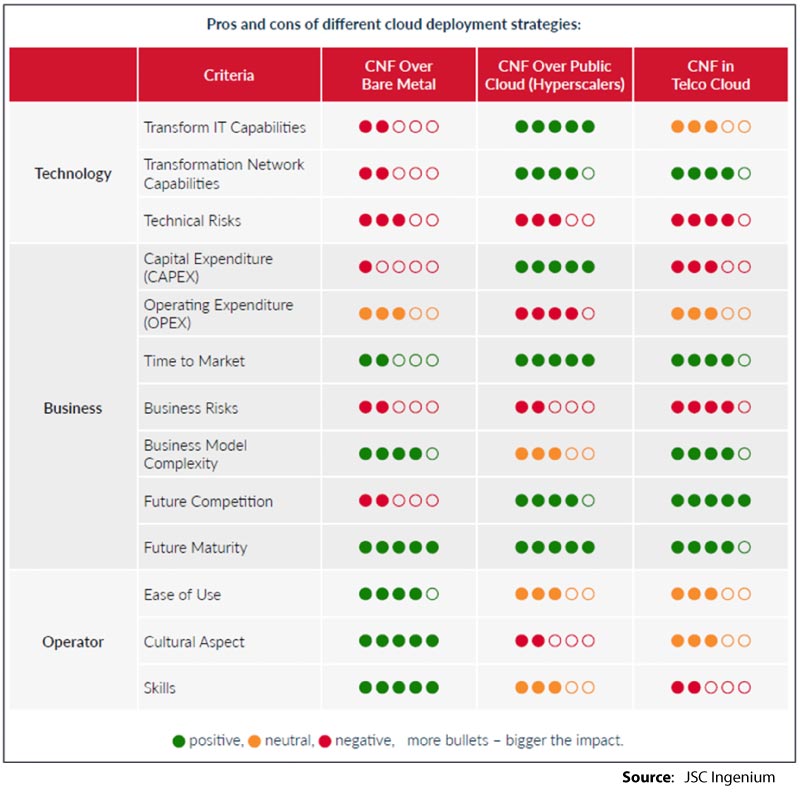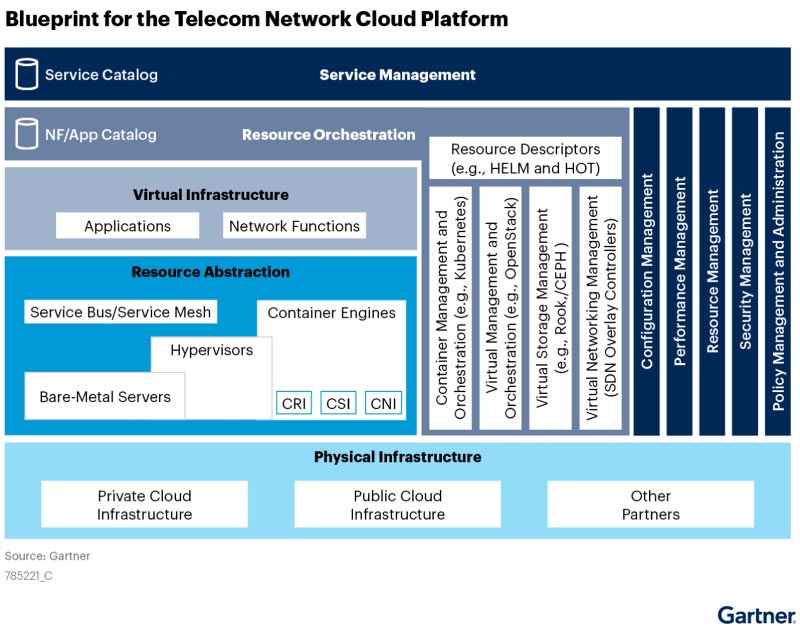* Building a Cloud-Native Telecom Infrastructure: Overcoming Challenges with Gartner’s Recommendations
In this post, we will explore the importance of cloudification for CSPs, the potential scenarios of public, private, and hybrid cloud deployment, and delve into those challenges and explore some of the key points of Gartner report “Key Principles for the Design and Implementation of a Cloud-Native Telecom Infrastructure”.
Cloudification as a Strategic Imperative
The trend extends to core network functions in the public cloud, where over 50% of CSPs are expected to participate by 2028, up from 18% in 2023.
- One of the primary advantages is enhanced agility. Cloud-based solutions enable CSPs to quickly adapt to changing market conditions, deploy new services, and scale resources as needed, without the constraints of traditional infrastructure.
- Scalability is another key driver. The ability to scale services up or down based on demand is a fundamental requirement for CSPs dealing with the unpredictable nature of communication services.
- Cloud environments provide the flexibility to expand resources during peak periods and reduce them during off-peak times.
- Cloudification therefore enhances operational efficiency by streamlining processes, reducing redundancy, and enabling more agile responses to market demands. The versatility inherent in cloud-native platforms allows CSPs to dynamically adapt to changes, ensuring they stay at the forefront of innovation.
Choosing the Right Cloud Deployment Model
- Bare metal: Adopting the bare metal approach involves up-front expenditure in physical infrastructure for each virtualised network function. As the technologies are mature and reasonably familiar to existing staff, internal cultural is less disrupted but the scope to transform IT and network capabilities will be constrained in the future. Dependence on manual hardware set-up and provisioning limits agility and, potentially, longer-term improvements to competitiveness.
- Public Cloud: Hyperscale public cloud, delivered by third parties, requires substantial cultural and skills-oriented changes, but boasts considerable advantages in transforming IT and network capacities, empowering CSPs to compete more efficiently and accelerating the introduction of new services to the market. This model bestows upon CSPs cost-effective scalability and resource flexibility. Whilst reducing up-front CAPEX can be highly advantageous, predicting OPEX can present challenges. Furthermore, the absence of interoperability between competing hyperscalers poses a risk of vendor lock-in.
- Private Cloud: A dedicated, or telco cloud is a cloud purpose-built and managed by the CSP, offering more control over security and compliance, making them ideal for CSPs handling sensitive data or working in regulated industries. The initial CAPEX is higher than that of a hyperscaler but can be lower than that of the bare metal choice. Adopting new cultural, skills, and work practices is essential. The CSP gains comprehensive authority over their network, competitiveness, and time to market for novel services. OPEX gains more predictability while business models simplify sans the engagement of a hyperscaler.
Embracing cloud computing’s design and architectural concepts empowers CSPs to fully capitalise on the capabilities of the cloud. The use of microservices allows for the implementation of continuous integration, continuous testing, and continuous delivery (CI/CT/CD) methodology in software development, resulting in faster development cycles, shorter time to market, and lowered risk and impact of human error.
The use of microservices allows for the implementation of continuous integration, continuous testing, and continuous delivery (CI/CT/CD) methodology in software development, resulting in faster development cycles, shorter time to market, and lowered risk and impact of human error. Independent building, testing, and deployment of microservices enables this approach.

A Guide for the Journey: Insights and Recommendations from Gartner
Insights from Gartner
Gartner outlines and summarises the problems for early adopters: “Vision, technical, organisational and cultural challenges have made the business impact more limited than was anticipated”.
Vision Challenges
The physical and organisational distribution also adds unique challenges for CSPs looking to transform or migrate their services.
Scaling up the abstraction model within this context demands a deep understanding of the underlying processes. Establishing a strong abstraction framework is crucial for a successful transition to a cloud-native infrastructure.
Technical Challenges
Legacy systems and outdated technologies often impede progress, making it challenging for CSPs to embrace cloud-native platforms.
This presents very real challenges for CSPs looking to justify their cloudification. As Gartner points out: “The lack of a strong impact on the bottom line is stressing CSPs’ finances, business strategy and future infrastructure evolution”.
The scarcity of cloud-skilled talent adds to the technical challenges.
Organisational and Cultural Challenges
Gartner’s Recommendations
Gartner provides strategic recommendations to help Communication Service Providers (CSPs) overcome challenges in building a cloud-native telecom infrastructure:
Cloud partnerships
Firstly, Gartner advise CSPs to leverage cloud partnerships, merging public and private cloud partnerships while utilizing internal private cloud capabilities for a versatile and robust infrastructure. Gartner emphasizes: “The current best practice being adopted by the telecom industry is to model the foundational elements of digital platforms on established cloud-native tools and projects from the open-source community”.

Focus on strategy
Secondly, according to Gartner, CSPs should strategically allocate resources, focusing on key elements such as architecture, security, and procurement: “Unless there is a well-identified business reason, they should leave to technology providers the responsibility for proposing the base IT/OT implementation, including frameworks for seamless technology and process integration”.
Modern application composition
Thirdly, Gartner encourages CSPs to embrace modern application composition – as the Gartner LIFESPAR model- emphasizing five foundational traits:
- Infrastructure agnosticism.
- Client-independent platform abstraction.
- Loosely coupled composable services.
- Integration.
- Automated lifecycle management.
Conclusion
Taking on board Gartner’s recommendations, CSPs can effectively navigate these obstacles. They can optimise their approach to building a cloud-native telecom infrastructure and position themselves for success in the telecommunications landscape of the future.

Key Principles for the Design and Implementation of a Cloud-Native Telecom Infrastructure
11 April 2023, Enrique Hernandez-Valencia
GARTNER is a registered trademark and service mark of Gartner, Inc. and/or its affiliates in the U.S. and internationally and is used herein with permission. All rights reserved.